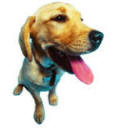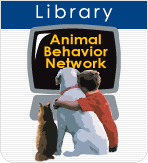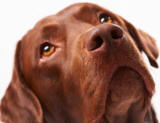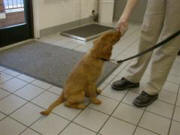|
Need Help?
|
|
Call
1-800-372-3706
to
speak to a Veterinary Behavior Technician |
|
Paws To Speak!
Member
Main Menu
|

Hand
Feeding

Pet Professional Tip
Lead by
example! Teach pups to sit on a floor scale for
accurate weights. Control unruly behavior with
positive instruction.
|
 |
|
Help is at your
fingertips by library, email and
phone. |

Click on
Library Icon
to learn more
|
It's a bonus not a bribe
Although some trainers feel that food should not be
used, it is a very useful, practical tool for
helping the dog to learn quickly what it is you want
them to do.
If
you use food, to get the dog to
do something they have already
learned how to do, then you are
using food as a bribe.
e.g. showing the dog a treat
before you ask the dog to
sit. You are also using food as
a bribe if you offer it as a
payoff to stop the dog from
doing something undesirable.
e.g. giving a dog a chew bone to
stop excessive barking.
|
A dog can earn a reward.
A bribe is showing the dog
the reward ahead of time.
A reward is a surprise
payoff for doing good work. |
However, you can use
food in two other ways that assist effective
learning and reinforce good behavior for a lifetime.
You can use food to lure or show the
dog what you are teaching them, and to reward
as a paycheck for doing good work.
If you
intermittently surprise the dog with a food reward
for responding quickly to your requests, then you
are using food as a bonus. Think of your praise as
the salary and the food treat as the bonus. This
helps to reinforce a dog that is attending to your
desires, awaiting your intentions, deferring to your
needs, and responding to what is learned.
Other training rewards can also be used such as squeaky toys, balls,
praise, petting, and any other thing the dog
perceives as a reward - but food will probably
provide the most motivation.
|
Think of your praise as a
salary and food treats as
bonuses. |
Using food as a teaching tool
To use food as a
teaching tool, use it as a lure. Hold the
treat right at the dog's.jpg) nose or lips and allow the dog
to attempt to nibble it. Then, move the food to
position the dog correctly. For example, if walk
backwards, moving the food forward, and the dog
follows, say the word, "come" to teach the dog that
walking to you is what you want. Lift the food
slightly up and then back so that the dog's head
tilts up and back until the dog naturally sits. As
the dog sits, say the word, "sit." Luring to
show the dog exactly what you want and pairing that
action with the desired word or cue is a terrific
use of food. It is much faster than placing the dog
physically into position because with luring, the
dog is thinking and figuring out the action on his
own. Using petting as a reward often confuses dogs
as they try to read our body language and respond to
our movements. Dogs will often learn hand signals
before they learn what words means.
nose or lips and allow the dog
to attempt to nibble it. Then, move the food to
position the dog correctly. For example, if walk
backwards, moving the food forward, and the dog
follows, say the word, "come" to teach the dog that
walking to you is what you want. Lift the food
slightly up and then back so that the dog's head
tilts up and back until the dog naturally sits. As
the dog sits, say the word, "sit." Luring to
show the dog exactly what you want and pairing that
action with the desired word or cue is a terrific
use of food. It is much faster than placing the dog
physically into position because with luring, the
dog is thinking and figuring out the action on his
own. Using petting as a reward often confuses dogs
as they try to read our body language and respond to
our movements. Dogs will often learn hand signals
before they learn what words means.

Some dogs work better for a special toy than
for food. Luring can be done using the
special toy by positioning it while withholding it until the action is
completed, then releasing the toy as the reward.
The advantage of
food is it can be used in
three ways.
First as a
lure,
second as a
reward,
and third as a
reminder. |